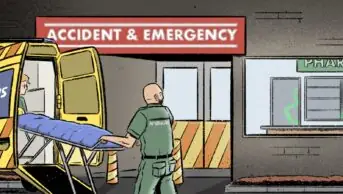
Wes Mountain/The Pharmaceutical Journal
Patients attending hospital emergency departments (EDs) have increasingly complex health needs with ever-growing medical conditions and associated polypharmacy. There is heightened pressure on the department and acutely unwell patients are staying longer within EDs owing to wider issues with patient flow.
Patients awaiting admission from the ED often face a delay in receiving their pharmacy review. Delays in medicines reconciliation can lead to omitted doses of time-critical medications (including Parkinson’s disease medications, antibiotics, anti-epileptics, insulin, anticoagulants and strong opiates), unconfirmed drug allergy statuses and the administration of medications that have the potential to cause harm and increase overall lengths of stay. Such delays have been highlighted as a concern by the Royal College of Emergency Medicine (RCEM).
The RCEM has recommended the use of dedicated ED pharmacists and pharmacy services to work as part of the multidisciplinary team (MDT) to help support the safe and efficient delivery of care to patients. Standards set by the RCEM in November 2023 concluded that pharmacist ED resuscitation (or trauma) cover should be provided. While this is an area with growing interest for a pharmacy provision, there are still multiple NHS trusts across the country with EDs that lack a dedicated pharmacy service.
ED ‘resus’ is the area where the most seriously unwell or injured patients are seen. Often this is separated into adults and paediatrics but may be combined in some NHS trusts. The purpose of the area is to be able to deliver life-saving interventions and offer space where trained staff, equipment and medications are available to do so in the most efficient way. The resus area can often be an intense environment to work within; however, pharmacists — with their expert knowledge in medicines, problem-solving skills and ability to critically think under pressure — are central to helping benefit patient care.
Working within the ED resus area as a prescribing pharmacist as part of a pilot, I encountered a middle-aged male patient with a background of epilepsy and severe learning difficulties. He was on a complex medication regimen to manage his conditions, and this was coupled with chronic dysphagia, which required his medicines to be administered via a percutaneous endoscopic gastrostomy — or ‘PEG’ — tube. The patient was admitted with sepsis secondary to aspiration pneumonia, and it was decided that the use of his PEG tube should be suspended because it may be contributing to the aspiration.
The prescribing function of a pharmacist is an element of the job role that really shows its weight in a place like the ED
Upon conducting a medication history for the patient, it was apparent that several of his time-critical medications, including his anti-epileptics, were overdue, increasing his risk of developing seizures. As we were unable to use the PEG tube, I was tasked with identifying alternative formulations and routes to enable administration. In some cases, this meant converting his liquid formulations to appropriate IV preparations and, in another case, providing suppositories for rectal administration.
As a pharmacist prescriber, this is where having an additional prescribing function was highly useful. I was able to prescribe the appropriate medications without requiring input from a physician, enabling faster administration and preventing missed doses.
The patient was also on a continuous subcutaneous syringe driver of medicines that was not accounted for in his medical clerking. Being able to reconcile the syringe driver medicines and checking their clinical suitability meant prescribing them helped avoid missed doses of this patient’s very complex medicines regimen.
The prescribing function of a pharmacist is an element of the job role that really shows its weight in a place like the ED. For this patient, not only was I able to prescribe his pre-admission time-critical medicines, but I was also able to optimise his care very early on in his attendance to hospital. This included prescribing an appropriate antibiotic regimen to effectively treat aspiration pneumonia in the context of a penicillin allergy and acute kidney injury. The patient also lacked any venous thromboembolism (VTE) prophylaxis, for which he was at high risk, given his current condition, dehydrated state and immobility. I was able to safely prescribe prophylaxis in line with local guidelines.
While a pharmacist prescriber is a useful professional to have as part of the ED resus team, recognition of our own limitations is also important. I encountered this myself, given that the patient was receiving oxygen, which required a prescription. I sought assistance from the acute medical consultant for the appropriate prescribing for this, given that we needed to appropriately confirm the patient’s target oxygen saturations and appropriate scale 1 or 2 prescribing.
Effective communication is essential for the role of the ED pharmacist, which is amplified in resus. In the 30-minute review of this patient, there were countless healthcare professionals involved to ensure he received the best possible care. Being able to work as part of a MDT with a shared goal is very rewarding.
The feedback received from fellow clinicians and nurses was extremely positive, citing elements of care that pharmacy professionals excel at, such as alternative formulation prescribing and antimicrobial stewardship. The ability to do this in a safe and effective manner on this occasion helped release doctors and nurses to focus on their other essential duties in the busy ED.
The experience helped to identify the significant impact a pharmacist can have within an ED resus area and the positives it can bring, not only to patient care but to the wider MDT team.
Shane Kailla, principal pharmacist and advanced clinical practitioner pharmacist, acute and emergency medicine
1 comment
You must be logged in to post a comment.



Hi Shane, this is an incredible blog , I am in the process of starting up and ED pharmacy service in my trust. Our ED has a majors, minors, Rapid Asess and Treat area (RAT) and a Resus area. At the moment , I have two pharmacists and myself with one pharmacy technician. The pharacists are prescribers but none of us have worked in an ED before, what advice can you give?